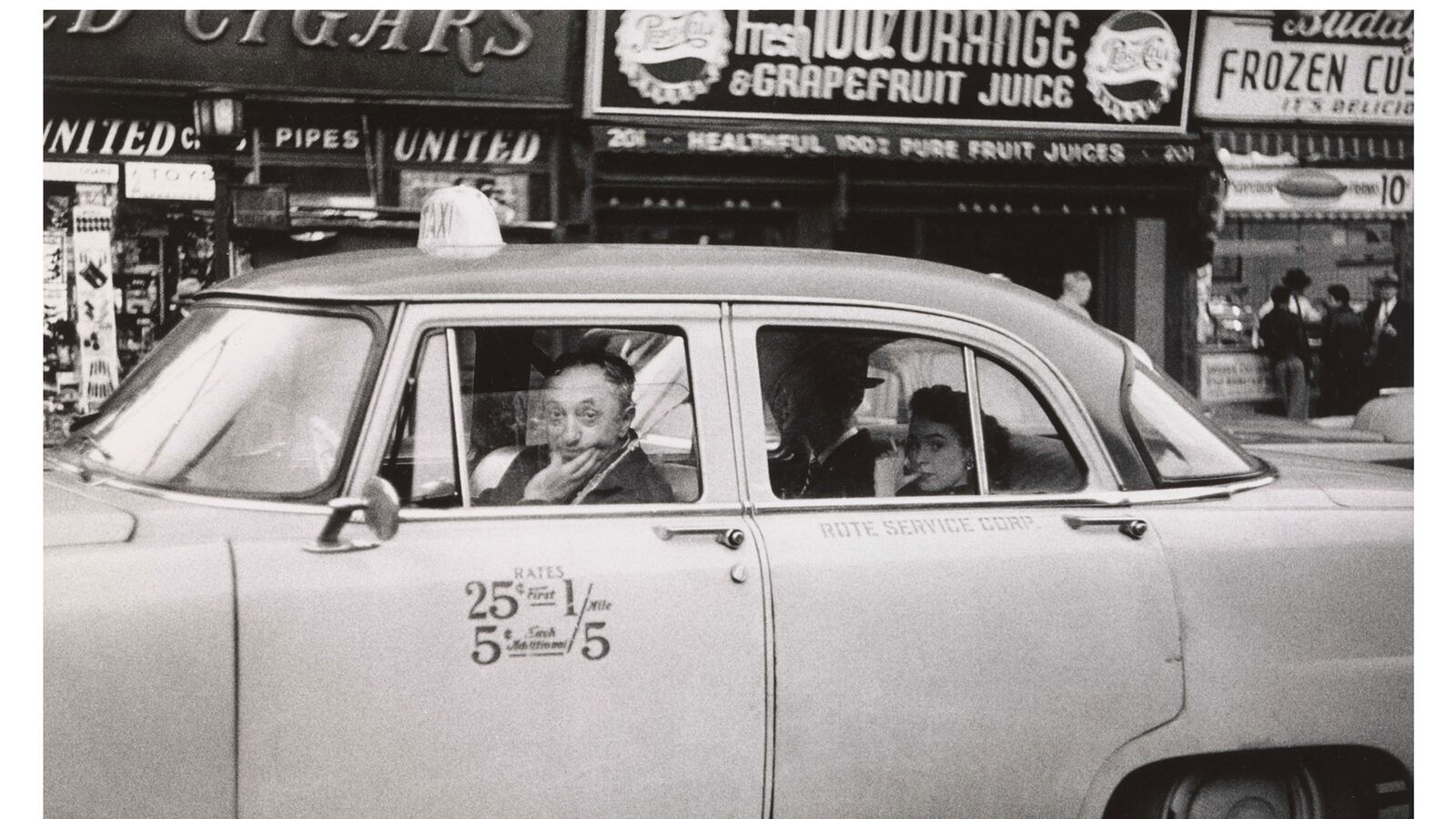On the third floor of the San Francisco Museum of Modern Art there is the best kind of gallery hush, as visitors peer closely at the photographs Diane Arbus took between 1956 and 1962, “in the beginning” (as the exhibition is titled) of her career, mostly on the streets of New York. These are just over a hundred images, pictures that are both intrusions and encapsulations of privacy.
“My favorite thing is to go where I’ve never been,” Arbus once said--one of many telling wall quotes. Sometimes in the gallery rooms you may hear a laugh, or a jolt of shock. I even heard one person profess to a female pal, “She really looks like you”--because Arbus photographed life as she found it. Spend more than a moment with each image, and you realize it is so much more than a simple portrait.
All of human life—and sometimes death-- is here, shot in black and white: rich and poor, young and old, male and female, all captured in moments of intimacy that can be piercing, hilarious, sad, shocking, and quotidian. Arbus’s great skill is to make the everyday and gritty look intriguing and mysterious. Hers is the most humane kind of documentary.
The photographs (the exhibit started life in New York last year at the Met Breuer) are each intriguing, and they also force the viewer to think how diverse a world we live in.
Arbus photographs all equally and non-judgmentally. It is both sad and instructive, now sixty years later when all is documented all the time, that should still seem radical and so surprising. “The thing that’s important to know is that you never know,” Arbus once said. “You’re always sort of feeling your way.”
Somehow Arbus—from first the 35mm format to the square format she adopted in 1962--strips away her subjects’ artifice and armors, and her subjects allow her to.
Here is a barbershop interior, Arbus outside the door, a barber looking up with a sudden smile at the lens. A boy in a hooded jacket looks considerably more serious. A puddle on the sidewalk should be grim but reflects the sky. A cab driver looks at Arbus with his hand on his chin, and his passenger with a thumb on her mouth.
On the subway a man nuzzles his baby, who looks directly at the camera. A female impersonator gets ready to perform. (Arbus’s pictures of the impersonators are radical in themselves: the subjects are not performing, the pictures of them are not lurid or wink-wink. The impersonators are beached between performance and off-stage personas; false eyelashes on, make-up applied, bare torsos, a feather boa slung over a closet door.
Arbus’s city is in perpetual motion and revelation. On the street, the wind whips pages of a newspaper, its headlines blurred. A woman on the street, a plump matron, shuts her eyes beatifically. Another woman, dressed all in black (like many subjects), looks almost mournful.
At a movie theatre, Arbus finds a handsome young usher in all his livery, and in Central Park a young woman, shot in the gathering gloom, carries a child with a look of urgency. On the street a Santa Claus looks resigned, while a woman hurries past him looking grave. A young woman looks out on to the teeming streets, her hear swept back.
Every picture tells a story, even glancingly: from the mannequin captured with its own strange glamor to a lady on a bus, facing Arbus defiantly while a man behind her gazes dreamily out of the window. A young man looks joyous with his hand behind his head, the lights of the city blurred behind him. Arbus photographs a wrestling match from above, the crowd in looming shadow, one fighter pinning another and referee frozen in the harshly lit distance.
Arbus’s subjects are often caught in physical transit, and the way she photographs them reveals them in an emotional transit too: the straight-face they present to the world is somehow made richer and more complex, hidden emotions suddenly visible, through Arbus’s lens. She once said, “I don’t press the shutter. The image does. And it’s like being gently clobbered.”
A clown’s sad face is lit by a shaft of light. An empty snack bar features cups, tables, and strip lighting and a menu split into sandwiches, cakes, and beverages. A boy in a crowd on an elder’s shoulders is dressed in his Sunday best, looking sweetly at Arbus, while the adults around him look fraught. Another boy in a mask larks around with his buddies on Coney Island, their faces full of mischievous youth and pleasure.
The funfairs and circus were favorite Arbus locations. She photographs a strongman flexing in white trunks, a trapeze artist in mid-act, and a ‘mood meter machine’ which ranges from ‘Frigid’ through to ‘Fiery’ (‘Ardent’ is the lit category). There are two cha-cha dancers, watched by a crowd that includes a coyly smiling woman, and a much more prim one. A father and his child are photographed at the Italian Street Festival, and a fire-eater is surrounded by licking flames.
Images on the cinema screen were subjects in themselves, whether it be Mickey Mouse in a western cartoon, a man on screen being choked, or Bela Lugosi as Dracula; and watching these flicks Arbus photographed the crowds themselves, and the beam of light from the projectors.
At a wax museum Arbus captured a staged axe-murder scene, and an in memoriam statue of James Dean, with Dean himself looking less hot young star in his prime and more ghostly old man.
One of the most stunning images, next to that, is of an old woman in a New York hospital. The photograph is almost all white—the bed-sheets, the woman herself, her face contorted in what may be a death mask or extreme pain. Next to that, Arbus heads into the morgue to photograph an actual corpse, its mid-section cut open, a tag on its toes.
Arbus photographed all strata of New York’s social order. Of the few black faces, one is of a handsome young man at a dance in 1960. A couple, listed as members of a Brooklyn teen gang, look sweetly square through contemporary eyes. And then we are at a grand opera ball, with a Miss Marian Seymour and her date the Baron, her face in dreamy, blurred profile.
Dead pigs are captured, hanging, their flanks shocking in their whiteness, while Miss Makrina, a little person, is photographed in her kitchen, mopping the floor. A couple arguing on Coney Island are shot in a kinetic riot of blurs, while on a sunny beach a man in fedora, trunks, and long socks is captured looking so utterly strange, but—like many Arbus subjects—looking stoutly sure and certain about his place in the world at that moment.
Arbus once said, “A photograph is a secret about a secret. The more it tells you the less you know.” As this exhibit shows, she never photographed the strange and offbeat to look so. She makes them look conventional, just as she makes the conventional look strange and offbeat. The freakish—whether that be the “human pin cushion” with needles in his face, or the “Jewish giant” towering over his parents in their living room—are documented with dignity, not to elicit easy laughs.
“The man who swallows razor blades” is photographed holding a baby. An Uncle Sam impersonator is photographed on his bed. In the suburbs, Arbus photographs a couple sunbathing on the lawn, she determined for momentary peace, he apparently irritated, and both oblivious to their son playing behind them. A female impersonator is photographed with his hair in curlers, while a Christmas tree is like its own horror movie monster looming over a suburban living room.
Arbus captures a young family on a Sunday outing, their faces an intriguing mix of emotions, and a young man in a straw hat waiting to march in a pro-war parade, with buttons that say, “Bomb Hanoi,” and “God Bless America: Support Our Boys in Vietnam.”
Linger on the image of young female identical twins: one looks friendly, one not-so. The husband and wife nudists in their living room remain ever-so-respectable. There are many other pictures to lose yourself in—ordinary people, circus people, old matrons—with the recurring mystery of who these people were, and whatever happened to them.
Arbus’s roving, empathetic eye was echoed in the work of her contemporaries and predecessors, and a final wall of images captures the best-known of them, including August Sander, Walker Evans, William Klein, and Robert Frank. (Bonus tip: before leaving, head to the seventh floor to see William Kentridge’s stunning 2012 installation, “The Refusal of Time,” an immersive collision of music, mechanics, and video.)
The final picture of Arbus’s I saw was of a girl on the street, holding a white handbag, photographed looking tentative. You can read that literally--she is caught in a moment of indecision—but there is also a more symbolic sense of a young woman on the verge of adulthood, the city in all its huge, strange glory, in front of her.
“Nothing is ever the same as they said it was. It’s what I’ve never seen before that I recognize,” Arbus once said--and this exhibit makes that intriguingly, beautifully clear.





